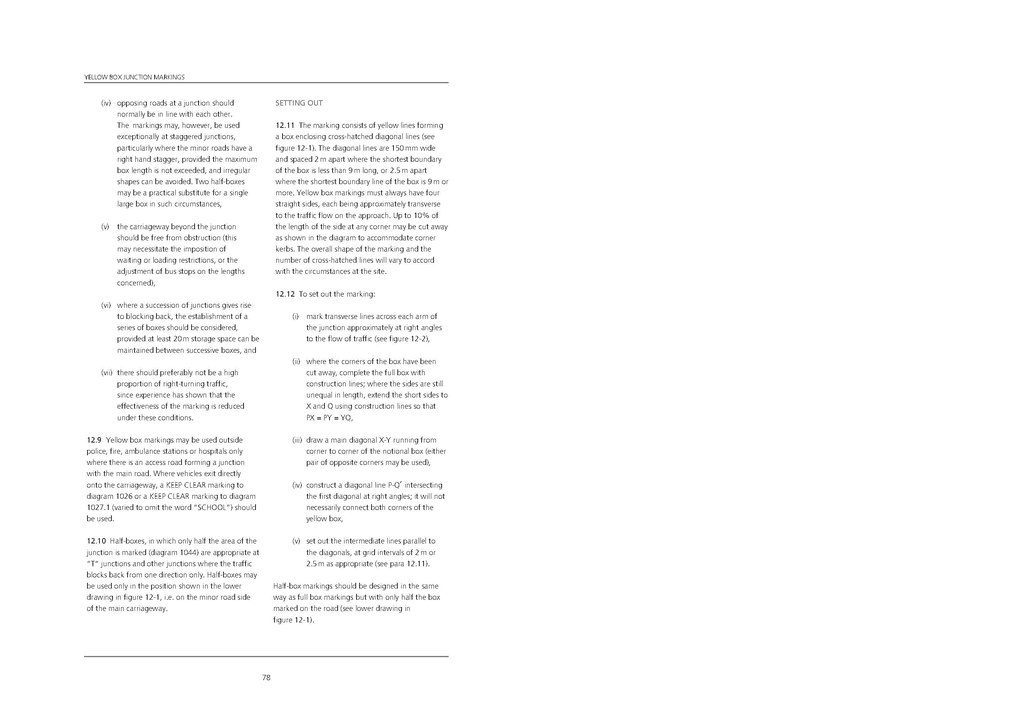(iv) opposing roads at a junction should normally be in line with each other. The markings may, however, be used exceptionally at staggered junctions, particularly where the minor roads have a right hand stagger, provided the maximum box length is not exceeded, and irregular shapes can be avoided. Two half-boxes may be a practical substitute for a single large box in such circumstances,
(v) the carriageway beyond the junction should be free from obstruction (this may necessitate the imposition of waiting or loading restrictions, or the adjustment of bus stops on the lengths concerned),
(vi) where a succession of junctions gives rise to blocking back, the establishment of a series of boxes should be considered, provided at least 20 m storage space can be maintained between successive boxes, and
(vii) there should preferably not be a high proportion of right-turning traffic, since experience has shown that the effectiveness of the marking is reduced under these conditions.
12.9 Yellow box markings may be used outside police, fire, ambulance stations or hospitals only where there is an access road forming a junction with the main road. Where vehicles exit directly onto the carriageway, a KEEP CLEAR marking to diagram 1026 or a KEEP CLEAR marking to diagram 1027.1 (varied to omit the word "SCHOOL") should be used.
12.10 Half-boxes, in which only half the area of the junction is marked (diagram 1044) are appropriate at "T" junctions and other junctions where the traffic blocks back from one direction only. Half-boxes may be used only in the position shown in the lower drawing in figure 12-1, i.e. on the minor road side of the main carriageway.
SETTING OUT
12.11 The marking consists of yellow lines forming a box enclosing cross-hatched diagonal lines (see figure 12-1). The diagonal lines are 150 mm wide and spaced 2 m apart where the shortest boundary of the box is less than 9 m long, or 2.5 m apart where the shortest boundary line of the box is 9 m or more. Yellow box markings must always have four straight sides, each being approximately transverse to the traffic flow on the approach. Up to 10% of the length of the side at any corner may be cut away as shown in the diagram to accommodate corner kerbs. The overall shape of the marking and the number of cross-hatched lines will vary to accord with the circumstances at the site.
12.12 To set out the marking:
(i) mark transverse lines across each arm of the junction approximately at right angles to the flow of traffic (see figure 12-2),
(ii) where the corners of the box have been cut away, complete the full box with construction lines; where the sides are still unequal in length, extend the short sides to X and Q using construction lines so that PX = PY = YQ,
(iii) draw a main diagonal X-Y running from corner to corner of the notional box (either pair of opposite corners may be used),
(iv) construct a diagonal line P-Q’ intersecting the first diagonal at right angles; it will not necessarily connect both corners of the yellow box,
(v) set out the intermediate lines parallel to the diagonals, at grid intervals of 2 m or 2.5 m as appropriate (see para 12.11).
Half-box markings should be designed in the same way as full box markings but with only half the box marked on the road (see lower drawing in figure 12-1).
78
